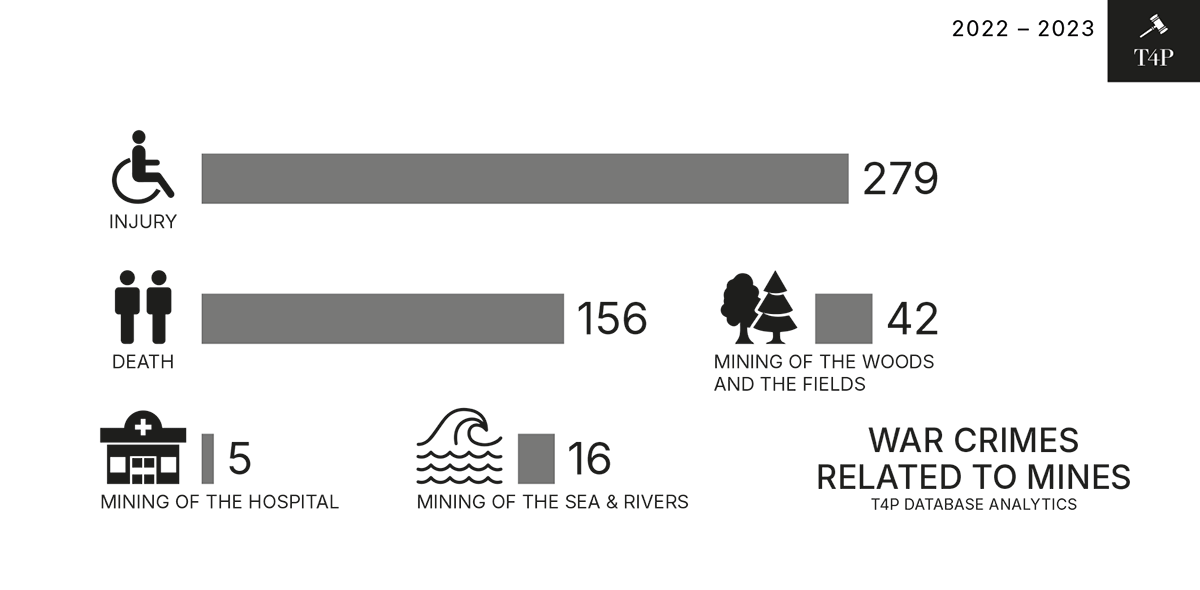On land and sea: Planting mines in Ukraine
![© Марія Крикуненко / Харківська правозахисна група [міни мапа україни карта мінування]](https://t4pua.org/files/img/1604923695.png)
Back in May 2023, the UN system coordinator in Ukraine, Denise Brown, during a speech at the Kyiv Security Forum, called Ukraine “the most contaminated country in the world in terms of mines.”
In a Time commentary, Deputy Prime Minister of Ukraine Yuliia Svyrydenko noted that “the scale of Ukraine contamination with mines and unexploded ordnance is the largest since the Second World War.” According to an estimate published by GLOBSEC, a think tank in Slovakia, it will take Ukraine 757 years to repair the damage.
The Tribunal for Putin (T4P) initiative recorded 770 cases previously qualified by documenters as “planting landmines.”

Most of the cases in the database concern civilian casualties from mine explosions. In 279 cases, people were injured, and in 156 they died.
At least 21 cases were confirmed to have been caused by the PFM-1 anti-personnel mine, known as the “petal”.

On 30 September 2023, at approximately 11:15 am, in the forest near the village of Oskil, Bohodukhovsky district, Kharkiv Region, a resident stepped on an anti-personnel mine of the PFM-1 type in the forest. According to the regional state administration, he received moderate injuries and was hospitalized.
It is also known about a resident of the village of Snizhkivka who stepped on an explosive device in his yard. As a result of the explosion, the man's foot was torn off.
![Кам’янка, Харківська область. © Оксана Комарова / Харківська правозахисна група [міна пфм лепесток пелюстка]](https://t4pua.org/files/img/1604923677.jpg)
On 14 April 2023, the Kharkiv region police reported two cases of injury to civilians in Izium. In one of them, a 29-year-old woman was allegedly injured when she stepped on PFM-1 while cleaning near a market kiosk.
In some places, children also suffer from mine explosions. On 15 October 2023, in the Bashtanski district of the Mykolaiv Region, two teenagers were blown up by a mine while playing in a field outside the village. One of the boys, born in 2008, died, and the other, born in 2011, was taken to the hospital with mine explosion injuries.
![Depositphotos [рятувальник дснс несе снаряд під час розмінування міни]](https://t4pua.org/files/img/1604923681.jpg)
In another village in the Mykolaiv Region, 10-year-old Artem Antonenko died. In March 2022, he went with his uncle on a tractor to pull out a car and ran into a mine. The uncle managed to survive - he was wounded.
11-year-old Danylo Kharchenko died on the Chernihiv-Kyiv highway when his family tried to evacuate. His brother and mother also died due to a mine explosion.
In some cases, people have died due to their negligence by ignoring warning signs. In the border strip in the Rivne Region, a tractor with two men drove into a field, ignoring a sign and fences about the territory having landmines. One person was killed, and another was injured.
![© Віталій Коваль / Telegram [рівненщина трактор підірвався на міні міни поле]](https://t4pua.org/files/img/1604923676.jpg)
Farm workers blow themselves up in fields with landmines
Farmers are among those who suffer the most from mines. A collision with agricultural machinery activates undetected anti-tank mines. Since such mines are designed for heavy armored vehicles with enhanced protection, the tractor driver often does not have a chance to survive the explosion.
In Shyroka Balka in the Kherson Region, a farmer ran into an enemy mine during fieldwork. The injuries he received were too severe. Arriving medics only confirmed the death.
![© Херсонська обласна прокуратура [трактор підірвався на міні]](https://t4pua.org/files/img/1604923683.jpg)
![© Херсонська обласна прокуратура [трактор підірвався на міні]](https://t4pua.org/files/img/1604923684.jpeg)
On 11 October 2023, a combine harvester was blown up by a mine in a field near the town of Snihyrivka, Mykolaiv Region. As a result of the explosion, the driver was injured and was taken to the hospital.
![© Сергій Шайхет / Telegram [Комбайн, що наїхав на міну під Снігурівкою, 11 жовтня 2023 року]](https://t4pua.org/files/img/1604923685.jpg)
On 17 March 2023, in the Mykolaiv Region, a 50-year-old tractor driver received mine explosion injuries while preparing the land for sowing.
The T4P database contains 42 cases of landmines in fields, forests, or the vicinity of populated areas.
In June 2022, authorities reported that the Russians were carrying out systematic and distant mining of territories in the Chuhuivskyi district of the Kharkiv Region. It was emphasized that mining occurs from a distance with the help of helicopters and multiple-launch rocket systems.
Farmer Oleksandr Mazurov from the liberated village of Velyka Komyshuvakha says that he suffered losses of four million dollars - his enterprise found itself on the front line. In addition to the immediate losses, the farm lost the opportunity to cultivate the land until the fields were cleared.
In July 2023, the Center for National Resistance reported that in the temporarily occupied territories of southern Ukraine, in particular in the Melitopol district of the Zaporizhzhia Region, Russian troops are installing minefields in sown fields, and sometimes just on dirt roads.
Planting mines in the hospitals
In the city of Polohy, Russian military personnel seized and mined the internal territory of the district hospital. Staff and patients were warned not to return to the hospital. Wounded Russian soldiers remained on the hospital premises.
During the Ukrainian counter-offensive in the Kharkiv Region, the Russian military, leaving the occupied territory, mined the entire territory of the Balakliia hospital. When the hospital staff returned to the liberated city, they found the institution looted, mined, and the premises damaged. “They even attached mines onto gurneys and their legs. The sappers found it,” said hospital director Maryna Rudenko.
![© Балаклійська міська військова адміністрація / Facebook [Балаклійська клінічна багатопрофільна лікарня інтенсивного лікування після деокупації Харківщини]](https://t4pua.org/files/img/1604923686.jpg)
In total, T4P documented 5 cases of medical institutions being mined.
Sea mines
T4P has recorded planting mines in the Black Sea and rivers since the beginning of a full-scale war. Back in March 2022, Russian military forces laid mines on the recommended routes from the Bosphorus to Odessa. At the same time, Russian propaganda blamed the Ukrainians for this.
On 4 December 2023, an anchor mine carried to the coast by a storm was discovered near the village of Prymorske.
In October 2023, military sappers destroyed a sea mine that washed up to the coast near the city of Chernomorsk in the Odessa Region.
![© Сили оборони України / Telegram [Морська міна біля узбережжя Чорноморська]](https://t4pua.org/files/img/1604923691.jpg)
In one of the cases, an unknown object similar to a small gas cylinder was washed ashore near Mykolaiv. As it was later established, this was an anchor river mine.
![Стопкадр із відео Типичный Николаев / Telegram [Якірна річкова міна на побережжі Миколаївщини]](https://t4pua.org/files/img/1604923687.jpg)
Aviation is often used to mine water bodies. Four explosive devices were dropped by Russian aircraft on 10/24/2023.
On 24 November 2023, Russian aviation carried out two strikes within 24 hours in the direction of the navigation corridor using four aircraft weapons, presumably sea bottom mines.
Mines in the Black Sea put civilian shipping at risk and have already damaged several ships. In September 2023, an explosion occurred on board the vessel Seama (flying the flag of the Republic of Togo) off the coast of Romania. According to the crew, the ship encountered a mine.
In November 2023, a sea mine detonated near the ship Georgia S (flying the flag of Liberia), which was transporting grain. The vessel received minor damage, which did not prevent it from continuing on its route.

It should be noted that sea mining cannot be considered a war crime within the meaning of the Rome Statute. In addition to the Russian armed forces, the Ukrainian Navy may place mines to prevent potential amphibious operations against Ukrainian coastal cities.
Unlike the Ukrainians, who are defending their coast, the Russians are trying to create a naval blockade of Ukrainian ports, making it impossible to export grain and other goods, which is confirmed by planting mines along the trade routes. Let's not forget about the economic damage to coastal areas.
Mines at Zaporizhia NPP
The events at the Zaporizhzhia nuclear power plant have been the subject of worldwide attention since the first days of the full-scale invasion when the city of Enerhodar came under fire from multiple launch rocket systems.
Immediately after the occupation, it became known that the Russians had begun to lay mines at the station. The Insider's sources at Zaporizhia NPP reported suspicious activity of Russian soldiers on the territory of the power plant. There was also a video of Russian military trucks entering the Zaporizhzhia Nuclear Power Plant territory and unloading some cargo.
![Depositphotos [енергодар заес атомна електростанція]](https://t4pua.org/files/img/1604923678.jpg)
In October 2022, the former head of the State Inspectorate for Nuclear Regulation, Hryhorii Plachkov, stated that at the temporarily occupied Zaporizhzhya Nuclear Power Plant, occupying forces mined the first and second nuclear power units.
In July 2023, Ukrainian intelligence reported that mine-explosive barriers, which consist of remotely controlled and unguided directional anti-personnel mines.
![© Головне управління розвідки Мінобборони України [Мапа мінування ЗАЕС]](https://t4pua.org/files/img/1604923692.jpeg)
It is evident that the occupation of Zaporizhia NPP allows the Russians to use it for blackmail. The question arises: is mining a nuclear power plant more than a potential war crime?
According to Evhen Zakharov, the actions of the Russians should be considered genocidal since manipulations with nuclear energy can lead to mass deaths, and the occupiers are aware of this. “The threat of nuclear weapons is nothing more than a threat of genocide,” — says Zakharov.
Legal qualifications
The Rome Statute of the International Criminal Court does not explicitly prohibit using anti-personnel mines or mining territories. These actions, however, result in excessive civilian suffering unrelated to the military advantage.
Taking this into account, mining the territory and blowing up civilians with mines can be preliminarily qualified in accordance with subparagraph XX of paragraph b of Article 8, “war crimes” of the Rome Statute.
In 2017, Belgium proposed introducing a provision into the text of the Rome Statute that would explicitly ban the use of anti-personnel mines. Still, the participating countries did not support adopting such an amendment.
In 1997, the Convention on the Prohibition of the Use, Stockpiling, Production and Transfer of Anti-Personnel Mines and Their Destruction, also known as the Ottawa Convention, was signed. Ukraine ratified this convention on 18 May 2005.
![Depositphotos [табличка небезпечно міни]](https://t4pua.org/files/img/1604923679.jpg)
The Russian Federation is not a party to the Ottawa Convention. Countries such as the United States and the People's Republic of China have also not joined.
Ukraine's participation in this convention has become the subject of certain manipulations by international organizations. 01/31/2023 Human Rights Watch (HRW) released a report on the use of PFM-1 anti-personnel mines by the Ukrainian armed forces in the Izium area. A Kharkiv Human Rights Protection Group tried to prevent publication by proposing preliminary consultations with human rights activists and the Ukrainian Ministry of Defense. HRW did not respond to the proposal.
Learn more about how we collect data and view live statistics on war crimes during the Russian-Ukrainian war.
Editor: Denys Volokha, illustrations: Serhii Prytkin, Mariia Krykunenko